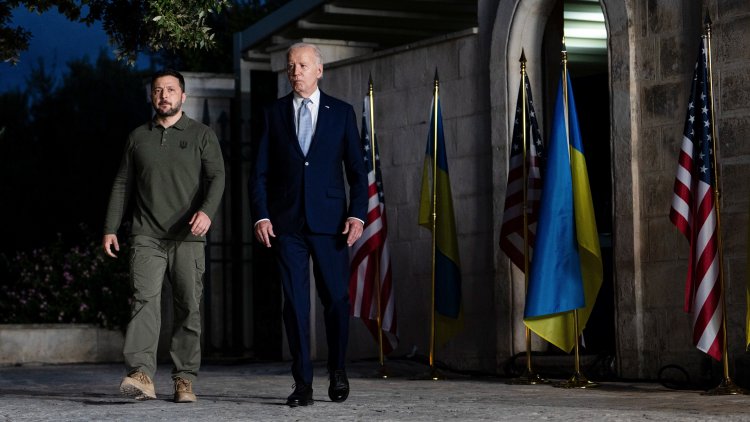The Final Six Months of U.S. Aid for Ukraine
Biden must take three steps to Trump-proof Ukraine’s cause.

The Ukrainian people may be six months away from losing military aid from the United States—again. President Joe Biden, however, seems not to recognize any urgency. When ABC’s George Stephanopoulos asked him how he’d feel if Donald Trump defeated him in November, Biden responded, “I’ll feel as long as I gave it my all and I did the good as job as I know I can do, that’s what this is about.” Biden’s personal feelings will be small consolation to the Ukrainian people, for whom Trump’s return could prove deadly.
Last year, the former president helped engineer what turned out to be an approximately four-month interruption in U.S. assistance to Ukraine, which Russia invaded in 2022. Trump has vowed to end the war quickly, which would likely mean letting Russia keep territory it seized in 2022 and giving Russian President Vladimir Putin an advantageous position for future invasions. Trump is leading in the polls. Biden’s administration—which has supported Ukraine steadfastly, albeit overcautiously in many respects—should be taking aggressive steps now to bolster that beleaguered country’s self-defense while it still can.
The administration could try to Trump-proof Ukraine specifically, and help Europe in general, in three different ways.
[McKay Coppins: What Europe fears]
The first thing the U.S. should do now is help Ukraine stockpile weaponry. Rather perversely, the administration has actually under-delivered on the aid that it was supposed to give Ukraine over the past year. A few billion dollars of congressionally authorized money went unspent at the end of 2023.
Now there can be no hesitation. This spring, Congress approved an additional $60 billion of assistance, and Biden’s team should make sure it is all in Ukrainian hands before the end of his current term. To some degree, European allies could help Ukraine make up for a loss of American aid, but sending U.S. assistance right away would maximize Kyiv’s ability to obtain items—such as 155-millimeter ammunition and Patriot air-defense systems—that Europe cannot provide in the same quantities.
Any hastily arranged stockpiles would, of course, be limited, but the larger they are, the longer they will last before Europe and other allies have to step in.
The second thing the administration should do is stop holding the Ukrainians back. For what seems to be an overblown fear of escalation with Putin, the U.S. has significantly limited which weapons systems it will give to Ukraine, and what Ukraine can do with the donated equipment. Long after Russia’s latest invasion, Ukraine will only now be getting F-16 aircraft (and certainly far from the most technologically capable of those fighters). Two and a half years after Russia started bombarding civilian targets all across Ukraine, Biden’s administration is still reluctant to allow Ukraine to use American weaponry against military targets inside Russia.
These limitations have given the Russians a major asymmetrical advantage: They can attack Ukraine safely from inside their own territory, while Ukraine needs to worry about being attacked anywhere at any time. Many allied European leaders, including Keir Starmer, Britain’s new prime minister, acknowledge this dynamic and have expressed their support for giving Ukraine more latitude to defend itself against attacks launched from Russian soil. The United States has still declined to support this.
Rather than constraining the Ukrainian war effort, Biden should provide the country with as many upgraded systems as possible, including more advanced F-16s and the air-to-surface cruise missiles known as JASSMs. The Ukrainians, knowing that Trump will almost certainly try to end their supply of U.S. weapons, would at least be able to make some gains for the time being.
[From the January/February 2024 issue: Trump will abandon NATO]
Finally, the U.S. could work with both Ukraine and European partners to ramp up the production of vital war matériel on Ukrainian soil or somewhere else in Europe. This doesn’t have to involve the most advanced American equipment—which the U.S. government would be reluctant to transfer. But Biden’s team could help Ukraine and Europe work together to build up reserves of essential components and establish new supply lines. There is no way that Ukraine or Europe could fully make up for the loss of U.S. aid, but Biden could help get them ready for that circumstance. Innovation cycles for weaponry have been very short in this war; when one side obtains more advanced fighting material, the other side tends to adjust its tactics within weeks. Ukraine needs access to nimble, adaptable suppliers whose work Trump has no capacity to interrupt.
All three of these steps are overdue and would help the Ukrainian war effort regardless of who is elected president of the United States in November. But the Biden administration should get moving now—both to improve Ukraine’s chances in the short term and to reassure European allies who are deeply uneasy about Trump’s return.
The Biden administration needs to face the reality that the current president might lose, and that Trump might be in a position to make Ukraine lose, and to disrupt America’s relationships with longtime allies in Europe for years to come. Eventually, Trumpist rule will end, and the United States will need friends and partners in Europe again. Biden can protect his country’s interests well into the future by leaving behind some reminders of America’s friendship and its willingness to work for a common good.
Biden claims to understand that Trump’s return would be a disaster for the United States and the world. If he helps Ukraine now, he has a chance to lessen that catastrophe. Anything else would be irresponsible.
What's Your Reaction?




















